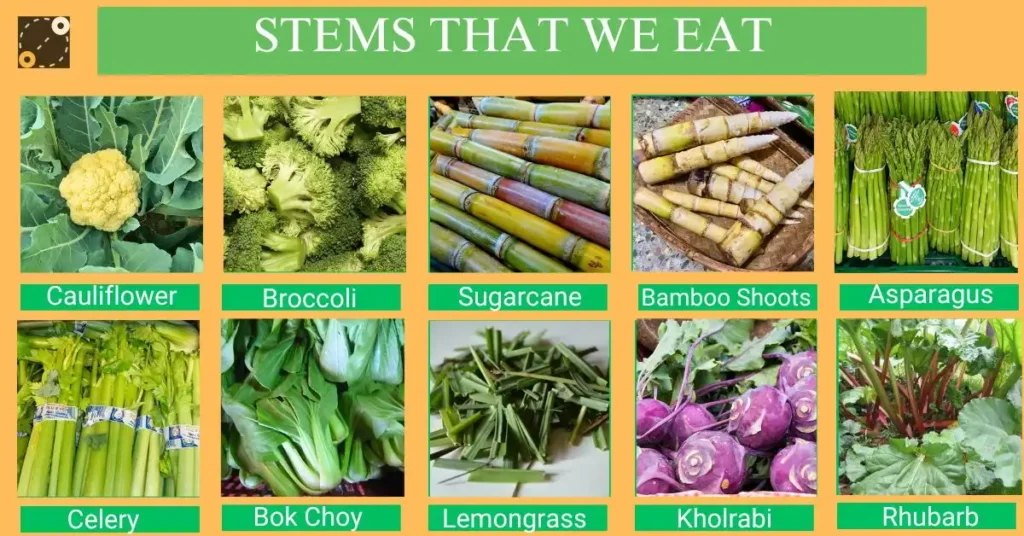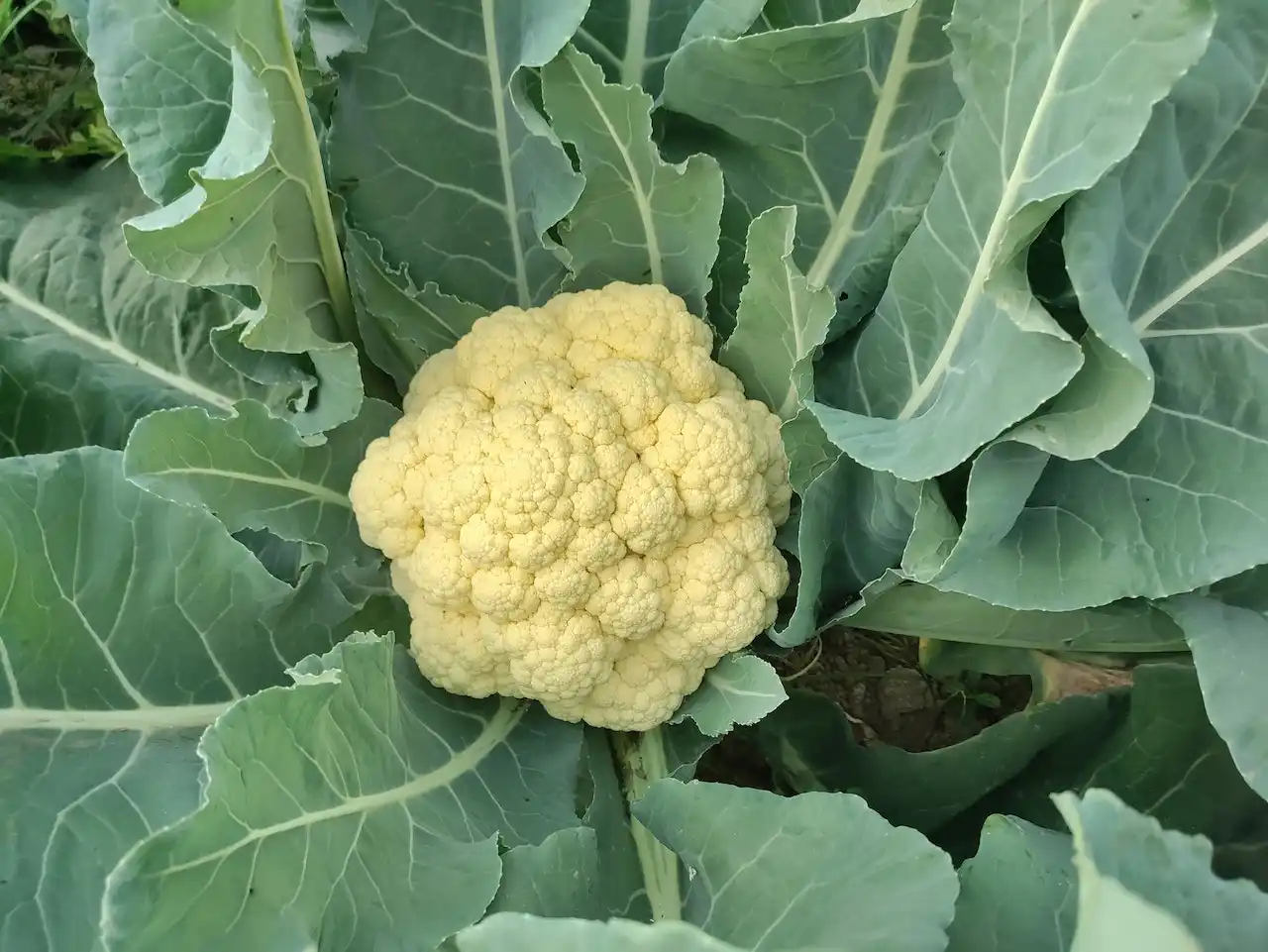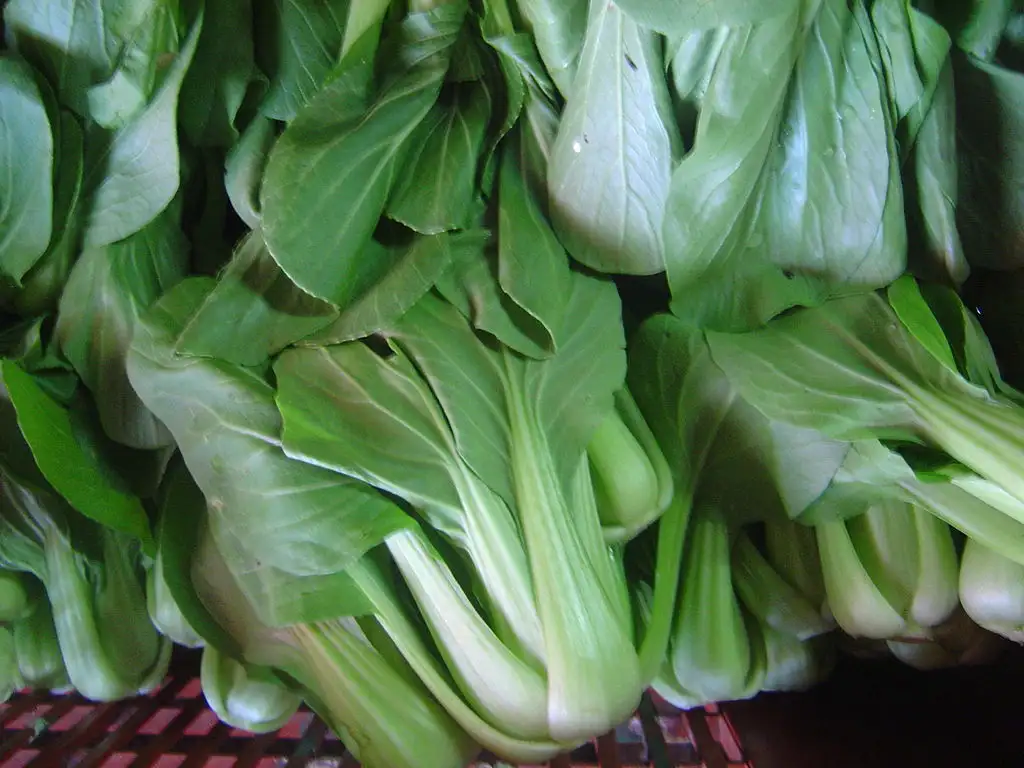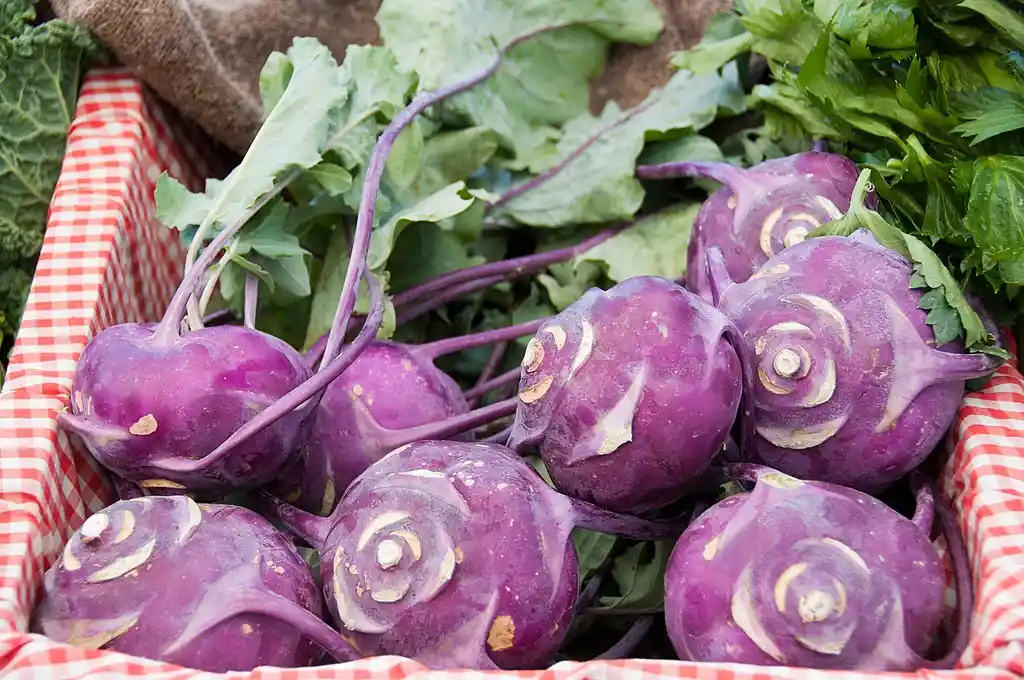We’ve eaten so many delicious fruits and vegetables offered by the plants right. But here’s the interesting part, did you know that we can eat the stems of a plant too? That’s right we eat that too! In this post we’re going to tell you about stems that we eat without even knowing that it’s not a fruit or veggie but a part of a plant itself.

So here is the list of 10 stem we eat as vegetables –
- Cauliflower
- Broccoli
- Sugarcane
- Bamboo Shoots
- Asparagus
- Celery
- Bok Choy
- Lemongrass
- Kohlrabi
- Rhubarb
Stems That We Eat
Let’s discuss these stem vegetables one by one and their benefits –
Cauliflower

Cauliflower in hindi is called Phool Gobhee. The Cauliflower plant is commonly eaten as a whole. But its stem is also perfectly edible and has a mild, slightly sweet taste. It is also used in a variety of dishes like soups and stews.
Cauliflower Benefits
Some of the amazing Cauliflower benefits and of it’s stem are –
- It is a great choice for weight control since it’s low in calories.
- High in nutrients like vitamin C, vitamin K, vitamin B6, folate, and fiber.
- Cauliflower contains antioxidant which reduces the risk of chronic diseases.
- Having Potassium and fiber, it lowers blood pressure as well.
- Nowadays many people opt for Cauliflower rice instead of simple rice since it’s gluten-free and low in carb.
Broccoli
Broccoli is a versatile vegetable and one of the many stems that we eat. It is used in salads, soups, stir-fries, and also as a side dish. Broccoli in hindi is known as Hari Phool Gobhi.

It’s a common stem of plant we eat just like Cauliflower but it has a milder flavor and a crisp, crunchy texture.
You can prepare the broccoli stalk, by removing the tough outer skin with a vegetable peeler or a knife. It can be cut into small pieces, which can be cooked or eaten raw also.
Broccoli Benefits
There are many benefits of Broccoli and it’s stem. Such as –
- Broccoli is really good for health as it’s rich in dietary fiber, which supports digestive health and blood sugar levels.
- This stem of plant we eat is often overlooked but is equally nutritious as the florets, containing vitamins, minerals, and fiber.
- Broccoli’s fiber, potassium, and antioxidants can contribute to heart health by improving cholesterol levels.
- It is a good source of calcium and vitamin K, both of which are important for maintaining strong and healthy bones.
- Protein in broccoli is not high compared to other foods, but it does contain a moderate amount of protein, for a vegetable.
However, Broccoli for thyroid is not good to eat in excessive amounts by people having thyroid related problems, because it contains goitrogens which can mildly interfere with thyroid function.
Sugarcane
Sugarcane in hindi is called ganna. Sugarcane is a well-known one in the different stems that we eat. It has a very sweet taste and is also used in many places as a source of sucrose. It is widely eaten raw as a snack and popularly consumed as a juice also.

According to the Indian Sugar Mills Association, India’s sugar production increased by 3.69% to 12.07 million tones during October to December 2022. The largest producer of sugarcane in India is Uttar Pradesh.
Sugarcane Benefits
There are huge benefits of eating sugarcane and benefits of sugarcane juice also –
- Rich in water content, sugarcane juice is a natural hydrating drink.
- The natural sugars in sugarcane provide a quick and natural source of energy.
- Sugarcane has vitamin C, B-complex vitamins (like B1, B2, B3, B5, and B6), calcium, potassium, magnesium, and iron. that support overall health.
- Chewing on sugarcane can help ease nausea and soothe an upset stomach.
- Sugarcane juice is very healthy as it’s natural sugars provide a quick energy boost, making it a natural alternative to processed sugary drinks.
- Due to the antioxidants and hydration in sugarcane juice people drink it a lot for healthier skin.
However, drinking sugarcane juice during fever is generally not recommended as it can stress digestion, potentially raise blood sugar levels, and hinder hydration efforts.
Many people are also confused that whether is sugarcane juice good for acidity? So, Sugarcane juice may not be the best choice for acidity, since it’s naturally high in sugar, which can trigger acidity and heartburn.
Bamboo Shoots

Bamboo Shoots are plant stem emerging from Bamboo plants. They have a mild, slightly nutty flavor and a crisp texture used in stir-fries, soups, salads and curries. But they are not very common stems that we eat and see in less dishes and cuisine. Bamboo shoots in hindi is called Baans or Kardi.
Bamboo Shoots Benefits
There are various benefits of Bamboo shoots –
- These stem vegetables are naturally low in fat, making them a healthy choice for those looking to reduce fat intake.
- The fiber in bamboo shoots act as a prebiotic, promoting the growth of beneficial gut bacteria.
- Bamboo shoots contain vitamins and minerals including vitamin C and zinc that support the immune system.
- These stem eating plants can also help stabilize blood sugar levels, which is beneficial for people with diabetes.
Asparagus
Another stem of plant that we eat is Asparagus which is known for its delicate taste. Asparagus in hindi is known as Shatavari. You can steam, roast, grill, sauté, or even consume raw Asparagus.

It’s a versatile vegetable that is used in salads, side dishes, omelets, pasta dishes, and much more. Since the tip of Asparagus shoots are tender with a milder taste people tend to like and consume that part more
Asparagus Benefits
Some of the Asparagus benefits are –
- They are particularly rich in folate or vitamin B9 and also contain minerals like potassium, iron, and calcium.
- With a high amount of fiber in these stems that we eat they help in digestion and regular bowel movements as well.
- It is really good for pregnant women as it is particularly rich in folate (vitamin B9), which is important during pregnancy for fetal development.
- It has anti-inflammatory properties.
- Asparagus vegetable helps in body’s natural detoxification.
- There are many Asparagus uses, such as in culinary, medically, agriculture use. One of it’s important use is that both of it’s roots and seeds are utilized to make medicines.
Celery

Celery vegetables is one of the stem eating plants which has a lot of benefits. Celery in hindi is known as Ajamoda. The leaves and seeds of the celery are also eaten and used in cooking as well. People also enjoy fresh Celery sticks as a snack, pairing it with dips like peanut butter, hummus, or cream cheese.
Celery Juice Benefits
Some of the Celery Juice benefits are and Celery benefits as well –
- Not just only a physical stem that we eat but Celery has recently gained popularity as a Celery juice health drink.
- It helps in hydration and has a good amount of flavonoids and polyphenols, which help fight stress.
- It can also be a healthy addition to someone’s weight management plan.
- People also tend to find their skin health much more improved, such as acne, after consuming celery juice regularly.
- There are many benefits of Celery itself, it contains phthalides which lower blood pressure.
- The fiber, potassium, and antioxidants in celery contribute to heart health.
- One of the important celery benefits is that celery has natural diuretic properties, promoting healthy urine flow.
Bok Choy
Bok Choy, also called by the name of Chinese Cabbage, belongs to stem eating plants. Bok Choy in hindi is called Chini Ghobi or Paak choy. It is a leafy vegetable which offers a delightful fusion of textures and flavors. With a really unique appearance, it is a visual stunner and has a thick, white, and crunchy base with dark green, leafy tops.

Bok Choy taste can be described as mild, slightly peppery flavor. People like to use it in stir-fry dishes a lot. It is a also used a lot in many Korean and Chinese dishes.
Bok Choy Benefits
Some of the Bok Choy benefits and it’s stem are –
- This leafy green stem vegetable we eat contains antioxidants, such as vitamin C and beta-carotene, which prevent free radicals from damaging cells.
- It also tends to improve bone health as it contains vitamin K.
- The vitamin C and other antioxidants in Bok choy help support the immune system and reduce the risk of infections.
- Bok Choy plant contains beta-carotene, which is beneficial for eye health.
- Improves skin health.
Lemongrass
As the name says Lemongrass plant is a herb known for its lemony flavor and fragrance. Lemongrass in hindi is called Nimbu Ghaas. Most of the time people use it for its aroma but the tender portion of the Lemongrass stems that we eat is packed with flavors and taste. There is also Lemongrass oil which is known for its aromatic, citrusy scent.

There are many Lemongrass uses and not just in cooking but medicinal as well. These stem eating plants are used in Southeast Asian and Thai cooking a lot as a flavoring agent.
Lemongrass Benefits
- Lemongrass contains antimicrobial and antibacterial properties which help in infections.
- In traditional medicine, lemongrass has been used to reduce fever.
- There are various uses of lemongrass oil such as in perfumery, aromatherapy, and as a flavoring agent in dishes.
- Lemongrass oil also has antimicrobial, anti-inflammatory, and relaxation-promoting properties.
- Other Lemon grass oil use is that it alleviate muscle pain, headaches, and joint pain.
Lemongrass tea benefits
Other than Lemongrass oil, there are many Lemongrass tea benefits as well –
- Ease in cough and cold.
- Relieved indigestion
- Bloating and gas relief
- Detoxification
- Reduce inflammation
- Boost metabolism
- Helps in weight loss.
Kohlrabi
Another plant stems we can eat is that of Kohlrabi. It has a Cabbage like stalk but Turnip like appearance. Kohlrabi in hindi is called Gaanth Ghobi. The taste of kohlrabi is often described as a mild, sweet, and slightly peppery combination of flavors. Kohlrabi is a variety of cabbage leaf vegetable. Both the bulbous shoot and the leaves of kohlrabi are edible and used in salads, slaws, and stir-fries.

When cooked, Kohlrabi can be roasted, boiled, steamed, or added to soups and stews. The flavor is enhanced when sautéed or caramelized.
Kohlrabi Benefits
There are many benefits of Kohlrabi and it’s stem, such as –
- It is rich in Vitamin C, Vitamin K which perform important functions such as cell damage protection, blood clotting and bone health.
- This plant stem that we can eat is rich in dietary fiber as well it prevents constipation and other digestive disorders.
- Low-calorie and fiber-rich nature.
- low-calorie stem vegetable.
- High water content for hydration.
Rhubarb
Many people get confused. Is Rhubarb fruit or vegetable? Well Rhubarb is a vegetable, but it is sometimes used with fruits also, so out of the different stems that we eat this plant serves both the purposes. Rhubarb in hindi is called Rubarb.

Rhubarb stalks are known for their intensely tart and tangy flavor. The shoots of Rhubarb are used in baking, especially in pies, crisps, and crumbles. People also use it to make jams, and sauces.
Rhubarb Benefits
The benefits of Rhubarb and it’s stem are –
- Rhubarb is a good source of cellulose and pectin which keep one’s gut healthy.
- Some studies also suggest that certain compounds in rhubarb may help regulate blood sugar levels.
- It’s underground stems and roots is used in traditional Chinese medicines.
- One of the Rhubarb uses are that it’s roots are used in the leather tanning industry.
- It’s leaves and stalks are used to feed livestock as well.
So these are some of the stems that we eat. However, there are still many more stem we eat as vegetables such as Artichoke, Cardoon, Kale, Watercress, etc. All these have incredible benefits and are used greatly in cooking.
Conclusion
In this article we came to a conclusion that there are many plant stems that we eat which provide us essential nutrients while offering a variety of flavors and textures in cooking. Including these stem eating plants into our meals, we can enhance our culinary experiences, reduce food waste, and enjoy a diverse and nutritious diet.
Also Read :




